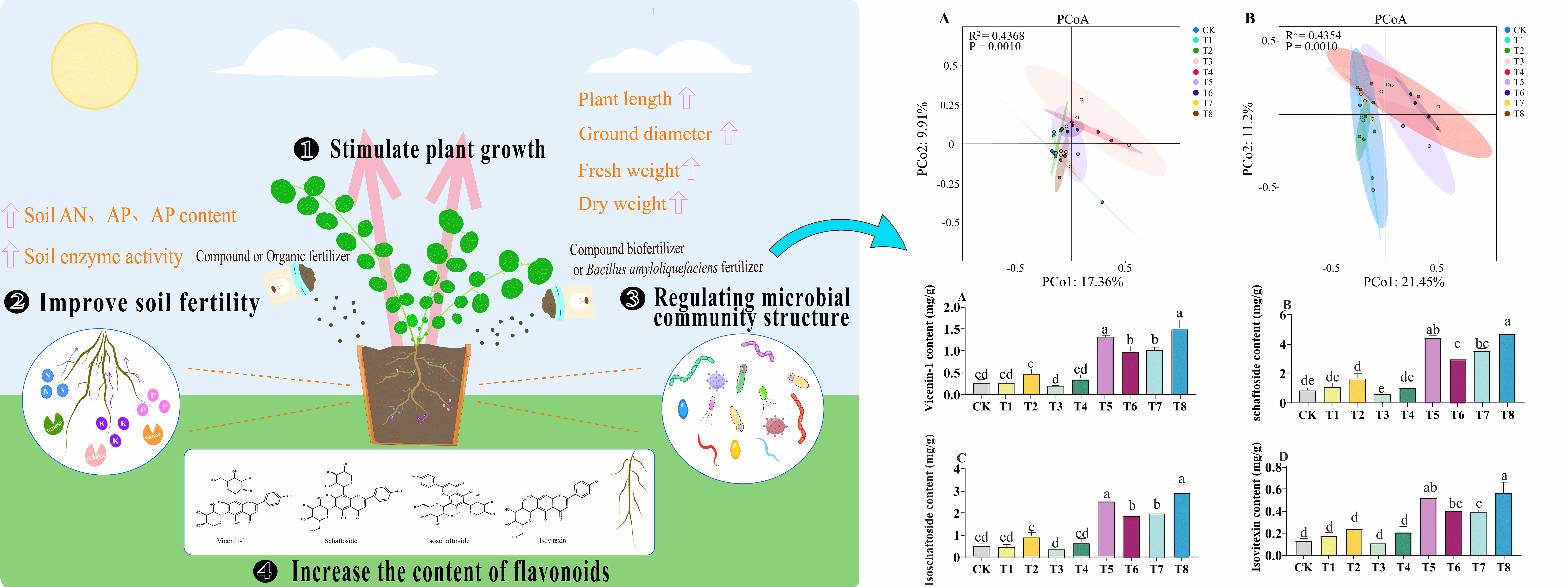 Open Access
Open Access
ARTICLE
Effects of Different Fertilization Treatments on the Growth, Quality, and Microbial Community Structure of Grona styracifolia
1 School of Chinese Materia Medica, Guangdong Pharmaceutical University, Guangzhou, 510006, China
2 Guangdong Provincial Research Center on Good Agricultural Practice & Comprehensive Agricultural Development Engineering Technology of Cantonese Medicinal Materials, Guangzhou, 510006, China
3 Comprehensive Experimental Station of Guangzhou, Chinese Material Medica, China Agriculture Research System (CARS-21-16), Guangzhou, 510006, China
4 Key Laboratory of Production & Development of Cantonese Medicinal Materials, State Administration of Traditional Chinese Medicine, Guangzhou, 510006, China
* Corresponding Authors: Quan Yang. Email: ; Xiaomin Tang. Email:
Phyton-International Journal of Experimental Botany 2025, 94(3), 843-860. https://doi.org/10.32604/phyton.2025.063062
Received 03 January 2025; Accepted 25 February 2025; Issue published 31 March 2025
Abstract
Fertilization is essential for high yield and quality in Chinese herbs. Grona styracifolia (Osbeck) H. Ohashi, a distinctive medicinal plant in the Lingnan region, currently encounters cultivation issues stemming from the overuse of chemical fertilizers. Adopting organic and microbial fertilizers presents a sustainable solution for its cultivation management. This study compared a no-fertilization control group with eight treatment groups using various concentrations of compound, organic, compound microbial, and Bacillus amyloliquefaciens fertilizers to evaluate their effects on G. styracifolia and soil microbial communities. The results demonstrated that the different fertilization treatments significantly enhanced plant growth and quality of G. styracifolia, while also increasing the activity of soil enzymes such as urease, invertase, and cellulase, as well as the levels of effective soil nutrients. Comprehensive affiliation function analysis demonstrated that applying Bacillus amyloliquefaciens fertilizer (15 g/kg) exhibited optimal performance in enhancing the growth of G. styracifolia and improving soil fertility parameters. Microbial sequencing of the soil indicated that under the application of Bacillus amyloliquefaciens fertilizer (15 g/kg), the relative abundance of Actinobacteria and Ascomycota increased significantly by 27.42% and 74.91%, respectively (p < 0.05). The application of microbial-based fertilizers significantly enriched the abundance of Mortierellomycota. Furthermore, LEfSe analysis identified distinct microbial biomarkers associated with different fertilizers. Additionally, redundancy analysis identified Invertase and available potassium (AK) as the primary drivers of soil bacterial and fungal community structures, respectively. This study demonstrated that the application of Bacillus amyloliquefaciens fertilizer (15 g/kg) significantly enhanced soil fertility and restructured microbial communities. These improvements led to increased yield and quality of G. styracifolia, providing a scientific foundation for sustainable cultivation.Graphic Abstract

Keywords
Cite This Article
 Copyright © 2025 The Author(s). Published by Tech Science Press.
Copyright © 2025 The Author(s). Published by Tech Science Press.This work is licensed under a Creative Commons Attribution 4.0 International License , which permits unrestricted use, distribution, and reproduction in any medium, provided the original work is properly cited.


 Submit a Paper
Submit a Paper Propose a Special lssue
Propose a Special lssue View Full Text
View Full Text Download PDF
Download PDF Downloads
Downloads
 Citation Tools
Citation Tools